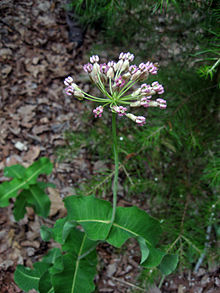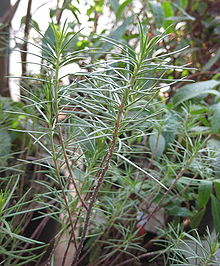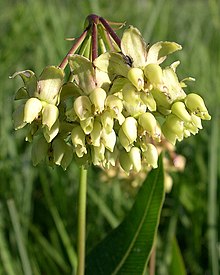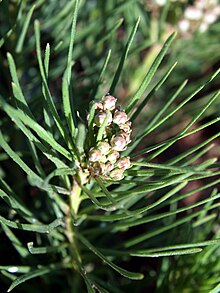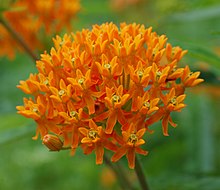Silk plants
| Silk plants | ||||||||||||
|---|---|---|---|---|---|---|---|---|---|---|---|---|

|
||||||||||||
| Systematics | ||||||||||||
|
||||||||||||
| Scientific name | ||||||||||||
| Asclepias | ||||||||||||
| L. |
The silk plants ( Asclepias ) are a genus of plants from the subfamily of the silk plants (Asclepiadoideae) within the family of the dog poison plants . Their original home is mainly the New World , some species are neophytes in many areas of the world .
description

Appearance and leaves
Asclepias species usually grow as perennial, rarely as annual herbaceous plants ; most species lignify somewhat at the base. Most of the time, the most short-stalked leaves are cross-opposite or, more rarely, they are arranged in whorls on the stems. The herbaceous leaf blades are linear, triangular, elliptical or elongated, with a length of 2 to 17 cm and a width of 0.1 to 3 cm, with a rounded, wedge-shaped or blunt blade base and pointed or pointed ends. The leaf surfaces can be hairy bald to downy.
Inflorescences and flowers
The terminal or between the nodes (nodes), umbel-like, zymous inflorescences are few to mostly multi-flowered. The inflorescence shafts are usually at least as long as the flower stalks, sometimes they are absent. The hermaphroditic and nectar-bearing flowers are radial symmetry , usually five-fold with a double flower envelope . The mostly five sepals are fused and hairy or bald on the underside. The usually five only fused at their base petals are upright to turned back. There is only one circle with five stamens . The stamens and the tip area of the carpels are fused together to form a so-called gynostegium . The upright gynostegium has curved, tongue-horn-like appendages. The two upper carpels are free from each other. Pollination is mostly done by insects ( entomophilia ).
Fruits and seeds
For each fertilized flower, two follicles emerge , which usually stand together like two horns. The spindle-shaped follicles have a pointed end and contain many flat seeds, densely packed, which have silky hairs 15 to 40 mm long as flight organs (coma) (hence the name silk plants).
Systematics
The genus Asclepias belongs to the subtribe Asclepiadinae from the tribe Asclepiadeae in the subfamily of the Asclepiadoideae within the family of Apocynaceae. The generic name Asclepias was first published in 1753 by Carl von Linné in Species Plantarum , 1, pp. 214-217. As a lectotype in Hitchcock: Prop. Brit. Bot. 1929, p. 136, Asclepias syriaca . Carl von Linné derived the botanical generic name Asclepias from Asklepios , the Greek god of healing, as it was often used in folk medicine . Synonyms for Asclepias L. are: Acerates Elliott , Anantherix Nutt. , Asclepiodella Small , Asclepiodora A. Gray , Biventraria Small , Oxypteryx Greene , Podostemma Greene , Podostigma Elliott , Schizonotus A. Gray , Solanoa Greene .
The genus of silk plants ( Asclepias ) includes over 200 species:

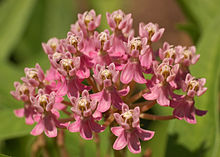

- Asclepias adscendens (Schltr.) Schltr. : It occurs from eastern Zimbabwe to southern Africa.
- Asclepias × aequicornu E. Fourn . = Asclepias candida × Asclepias mellodora : It occurs in Brazil and in the Argentine Misiones.
- Asclepias albens (E.Mey.) Schltr.
- Asclepias albicans S. Watson
- Asclepias alpestris (K.Schum.) Goyder
- Asclepias amabilis N.E.Br.
- Asclepias ameliae S.Moore
- Asclepias amplexicaulis Sm.
- Asclepias angustifolia Schweigg.
- Asclepias apocynifolia Woodson
- Asclepias arenaria Torr.
-
Asclepias asperula (Decne.) Woodson : There are two subspecies:
- Asclepias asperula (Decne.) Woodson subsp. asperula
- Asclepias asperula subsp. capricornu (Woodson) Woodson
- Asclepias atroviolacea Woodson
- Asclepias aurea (Schltr.) Schltr.
- Asclepias auriculata Kunth
- Asclepias barjoniifolia E. Fourn.
- Asclepias bartlettiana Woodson
- Asclepias baumii Schltr.
- Asclepias bicuspis N.E.Br.
- Asclepias bifida W.H. Blackw.
- Asclepias boliviensis E. Fourn.
- Asclepias brachystephana Engelm. ex Torr.
- Asclepias bracteolata E. Fourn.
-
Asclepias breviantherae Goyder : It was first described in 2009 with two subspecies:
- Asclepias breviantherae Goyder subsp. breviantherae : It occurs from southwestern Tanzania to northern Malawi.
- Asclepias breviantherae subsp. minor Goyder : This endemic occurs only on the Kitulo Plateau in Tanzania.
- Asclepias brevicuspis (E.Mey.) Schltr.
- Asclepias brevipes (Schltr.) Schltr.
- Asclepias × bridgesii E. Fourn.
- Asclepias buchwaldii (Schltr. & K.Schum.) De Wild.
-
Asclepias californica Greene : There are two subspecies:
- Asclepias californica Greene subsp. californica
- Asclepias californica subsp. greenei Woodson
- Asclepias candida Vell.
- Asclepias cinerea Walter
- Asclepias circinalis (Decne.) Woodson
- Asclepias compressidens (NEBr.) Nicholas
- Asclepias concinna (Schltr.) Schltr.
- Asclepias connivens Baldwin ex Elliott
- Asclepias constricta M.E. Jones
- Asclepias conzattii Woodson
- Asclepias cooperi N.E.Br.
- Asclepias cordifolia (Benth.) Jeps.
- Asclepias coulteri A. Gray
- Asclepias crassicoronata Goyder : It was first described in 2009.
- Asclepias crassinervis N.E.Br.
- Asclepias crispa P.J. Bergius
- Asclepias crocea Woodson
-
Asclepias cryptoceras S.Watson : There are two subspecies:
- Asclepias cryptoceras S. Watson subsp. cryptoceras
- Asclepias cryptoceras subsp. davisii (Woodson) Woodson
-
Asclepias cucullata (Schltr.) Schltr. : There have been two subspecies since 2001:
- Asclepias cucullata (Schltr.) Schltr. subsp. cucullata
- Asclepias cucullata subsp. scabrifolia (S.Moore) Goyder
- Asclepias cultriformis Harv. ex Schltr.
- Indian milkweed ( Asclepias curassavica L. )
- Asclepias curtissii A. Gray
- Asclepias cutleri Woodson
- Asclepias densiflora N.E.Br.
- Asclepias dependens (K.Schum.) NEBr.
- Asclepias depressa (Schltr.) Schltr.
- Asclepias dinteri Engl. & Krause
- Asclepias disparilis N.E.Br.
- Asclepias dissona N.E.Br.
- Asclepias dregeana Schltr.
- Asclepias edentata Goyder : It was first described in 2009 from southwestern Tanzania.
- Asclepias elata Benth.
- Asclepias elegantula Fishbein : It was first described in 2008 from northern Mexico.
- Asclepias eminens (Harv.) Schltr.
- Asclepias emoryi (Greene) Vail ex Small
- Asclepias engelmanniana Woodson
- Asclepias eriocarpa Benth.
- Asclepias erosa Torr.
- Asclepias euphorbiifolia Engelm. ex A. Gray
- Asclepias exaltata L.
- Asclepias expansa (E.Mey.) Schltr.
- Asclepias fallax (Schltr.) Schltr.
- Asclepias fascicularis Decne.
- Asclepias feayi Chapm. ex A. Gray
- Asclepias fimbriata Weim.
- Asclepias flanaganii Schltr.
- Asclepias flexuosa (E.Mey. Ex Decne.) Schltr.
- Asclepias foliosa (K.Schum.) Here
- Asclepias fournieri Woodson
- Asclepias fulva N.E.Br.
- Asclepias galeottii E. Fourn.
- Asclepias gentryi Standl.
-
Asclepias gibba (E.Mey.) Schltr. : There are two varieties:
- Asclepias gibba (E.Mey.) Schltr. var. gibba
- Asclepias gibba var. Media NEBr.
- Asclepias glaucescens Kunth
- Asclepias gordon-grayae Nicholas
- Asclepias graminifolia (Wild) Goyder : This new combination took place in 2009.
- Asclepias grandirandii Goyder : It was first described in 2009.
- Asclepias hallii A. Gray
- Asclepias hirtella (Pennell) Woodson
- Asclepias humilis (E. Mey.) Schltr.
- Asclepias humistrata Walter
- Asclepias hypoleuca (A. Gray) Woodson
- Asclepias inaequalis Goyder : It was first described in 2009.
-
Marsh milkweed ( Asclepias incarnata L. ): There are two subspecies:
- Asclepias incarnata L. subsp. incarnata
- Asclepias incarnata subsp. pulchra (Hon. ex Willd.) Woodson
- Asclepias involucrata Engelm. ex Torr.
- Asclepias jaliscana B.L.Rob.
- Asclepias jorgeana Fishbein & SPLynch
- Asclepias kamerunensis Schltr.
- Asclepias × kansana Vail
- Asclepias labriformis M.E. Jones
- Asclepias lanceolata Walter
- Asclepias langsdorffii E. Fourn.
- Asclepias lanuginosa Nutt.
- Asclepias latifolia (Torr.) Raf.
- Asclepias lemmonii A. Gray
- Asclepias leptopus I.M.Johnst.
- Asclepias linaria Cav.
- Asclepias linearis Scheele
- Asclepias longifolia Michx.
- Asclepias longirostra Goyder : It was first described in 2009.
- Asclepias longissima (K.Schum.) NEBr.
- Asclepias lynchiana Fishbein
- Asclepias macropus (Schltr.) Schltr. .
- Asclepias macrotis Torr.
- Asclepias masonii Woodson
- Asclepias mcvaughii Woodson
- Asclepias meadii Torr. ex A. Gray
- Asclepias melantha Decne.
- Asclepias meliodora (Schltr.) Schltr.
- Asclepias mellodora A.St.-Hil.
- Asclepias mexicana Cav.
- Asclepias meyeriana (Schltr.) Schltr.
- Asclepias michauxii Decne.
- Asclepias minor (S.Moore) Goyder
- Asclepias minutiflora (Goyder) Goyder
- Asclepias mirifica Woodson
- Asclepias montevaga M.Glen, Nicholas & Bester
- Asclepias monticola N.E.Br.
- Asclepias mtorwiensis Goyder : It was first described in 2009. This endemic occurs only in the Kipengere Mountains in Tanzania.
- Asclepias nana I. Verd.
- Asclepias navicularis (E. Mey.) Schltr.
-
Asclepias nivea L .: There are two varieties:
- Asclepias nivea var. Intermedia Schltr.
- Asclepias nivea L. var. Nivea
- Asclepias nummularia Torr.
- Asclepias nummularioides W.D.Stevens
- Asclepias nuttii N.E.Br.
- Asclepias nyctaginifolia A. Gray
- Asclepias obovata Elliott
- Asclepias occidentallis Goyder : It was first described in 2009.
- Asclepias oenotheroides Schltdl. & Cham.
- Asclepias oreophila Nicholas ex Hilliard & BLBurtt
- Asclepias otarioides E. Fourn.
- Asclepias ovalifolia Decne.
- Asclepias ovata M. Martens & Galeotti
- Asclepias palustris (K.Schum.) Schltr.
- Asclepias patens N.E.Br.
- Asclepias pedicellata Walter
- Asclepias pellucida E. Fourn.
- Asclepias peltigera (E.Mey.) Schltr.
- Asclepias perennis Walter
- Asclepias pilgeriana Schltr.
- Asclepias praemorsa Schltr.
- Asclepias pratensis Benth.
- Asclepias pringlei (Greenm.) Woodson
- Asclepias prostrata W.H. Blackw.
- Asclepias pseudoamabilis Goyder : It was first described in 2009.
- Asclepias pseudofimbriata (Goyder) Goyder : This new combination took place in 2009.
- Asclepias pseudorubricaulis Woodson
- Asclepias puberula A. Gray
- Asclepias pumila (A. Gray) Vail
- Asclepias purpurascens L.
- Asclepias pygmaea N.E.Br.
- Asclepias quadrifolia Jacq.
- Asclepias quinquedentata A. Gray
- Asclepias randii S.Moore
- Asclepias rara N.E.Br.
- Asclepias rubra L.
- Asclepias rusbyi (Vail) Woodson
- Asclepias scaposa Vail
- Asclepias scheryi Woodson
- Asclepias schlechteri (K.Schum.) NEBr.
- Asclepias schumanniana Here
- Asclepias senecionifolia M.E. Jones
- Asclepias shabaensis (Goyder) Goyder : This new combination took place in 2009.
- Asclepias similis Hemsl.
- Asclepias solanoana Woodson
- Asclepias solstitialis A. Chev.
- Asclepias speciosa Torr.
- Asclepias sperryi Woodson
- Asclepias sphacelata (K.Schum.) NEBr.
- Asclepias standleyi Woodson
- Asclepias stathmostelmoides Goyder
- Asclepias stellifera Schltr.
- Asclepias stenophylla A. Gray
- Asclepias subaphylla Woodson
- Asclepias subulata Decne.
- Asclepias subverticillata (A. Gray) Vail
- Asclepias subviridis S.Moore
- Asclepias sullivantii Engelm. ex A. Gray
- Common milkweed ( Asclepias syriaca L. )
- Asclepias tanganyikensis E.A. Bruce
- Asclepias texana A. Heller
- Asclepias tomentosa Elliott
-
Asclepias tuberosa L .: There are three subspecies:
- Asclepias tuberosa subsp. interior Woodson (Syn .: Asclepias tuberosa subsp. terminalis Woodson )
- Asclepias tuberosa subsp. rolfsii (Britton ex Vail) Woodson
- Asclepias tuberosa L. subsp. tuberosa
- Asclepias ulophylla Schltr.
-
Asclepias uncialis Greene : There are two subspecies:
- Asclepias uncialis subsp. ruthiae (Maguire) JTKartesz & Gandhi
- Asclepias uncialis Greene subsp. uncialis
- Asclepias variegata L.
- Asclepias velutina (Schltr.) Schltr.
- Asclepias verticillata L.
-
Asclepias vestita Hook. & Arn. : There are two subspecies:
- Asclepias vestita subsp. parishii (Jeps.) Woodson
- Asclepias vestita Hook. & Arn. subsp. vestita
- Asclepias vicaria N.E.Br.
- Asclepias vinosa (E. Fourn.) Woodson
- Asclepias viridiflora Raf.
- Asclepias viridis Walter
- Asclepias viridula Chapm.
- Asclepias virletii E. Fourn .
- Asclepias welshii N.H. Holmgren & PKHolmgren
- Asclepias woodii (Schltr.) Schltr.
- Asclepias woodsoniana Standl. & Steyerm.
- Asclepias zanthodacryon (LBSm.) Woodson
Differences to the related genus Gomphocarpus
The genus Asclepias differs from the genus Gomphocarpus mainly in the slim to thick beet-shaped or bulbous rhizome , which in Gomphocarpus is fibrous or lignified. Asclepias forms new, mostly unbranched or slightly branched stems every year, while Gomphocarpus forms short-lived, perennial subshrubs with branched stems. Furthermore, the inflorescences in Asclepias are terminal, in Gomphocarpus on the other hand extra-axillary (arising from the leaf axils ).
swell
- Bingtao Li, Michael G. Gilbert, W. Douglas Stevens: Asclepiadaceae in der Flora of China , Volume 16, 1995, p. 203: Asclepias - Online. (Section description)
- S. Liede-Schumann & U. Meve 2006 .: The Genera of Asclepiadoideae, Secamonoideae and Periplocoideae (Apocynaceae) Descriptions, Illustrations, Identification, and Information Retrieval. Version: September 21, 2000. Genus Asclepias .
Individual evidence
- ↑ WA Dayton: Glossary of Botanical Terms Commonly Used in Range Research. United States Department of Agriculture, 1950, p. 10, archive.org .
- ^ Asclepias in the Germplasm Resources Information Network (GRIN), USDA , ARS , National Genetic Resources Program. National Germplasm Resources Laboratory, Beltsville, Maryland.
- ^ Asclepias at Tropicos.org. Missouri Botanical Garden, St. Louis
- ↑ a b c d e f g h i j k l m n o p q r s t u v w x y z aa ab ac ad ae af ag ah ai aj ak al am an ao ap aq ar as at au av aw ax ay az ba bb bc bd be bf bg bh bi bj bk bl bm bn bo bp bq br bs bt bu bv bw bx by bz ca cb cc cd ce cf cg ch ci cj ck cl cm cn co cp cq cr cs ct cu cv cw cx cy cz da db dc dd de df dg dh di dj dk dl dm dn do dp dq dr ds dt du dv dw dx dy dz ea eb ec ed ee ef eg eh ei ej ek el em en eo ep eq er es et eu ev ew ex ey ez fa fb fc fd fe ff fg fh fi fj fk fl fm fn fo fp fq fr fs ft fu fv fw fx fy fz ga gb gc gd ge gf gg gh gi gj gk gl gm gn go gp gq gr gs gt gu gv gw gx gy gz ha hb hc hd he hf hg hh hi hj hk hl hm hn ho hp hq hr hs ht hu hv Rafaël Govaerts (Ed.): Asclepias. In: World Checklist of Selected Plant Families (WCSP) - The Board of Trustees of the Royal Botanic Gardens, Kew . Retrieved January 3, 2020.
- ↑ a b c d e f g h i j k l m David John Goyder: A Synopsis of Asclepias (Apocynaceae: Asclepiadoideae) in Tropical Africa. In: Kew Bulletin. Volume 64, No. 3, 2009, pp. 369-399. JSTOR 20649668
- ^ A b Billie L. Turner: Taxonomy of Asclepias hirtella and A. longifolia (Apocynaceae). In: Phytologia. Volume 91, No. 2, 2009, pp. 308-311 online.
further reading
- Mark Fishbein, David Chuba, Chris Ellison, Roberta J. Mason-Gamer, Steven P. Lynch: Phylogenetic Relationships of Asclepias (Apocynaceae) Inferred from Non-coding Chloroplast DNA Sequences. In: Systematic Botany. Volume 36, Number 4, 2011, pp. 1008-1023, doi: 10.1600 / 036364411X605010 .
Web links
- Entries about Asclepias in Plants For A Future . Retrieved November 4, 2017.

